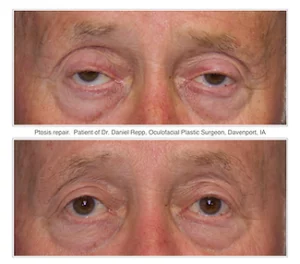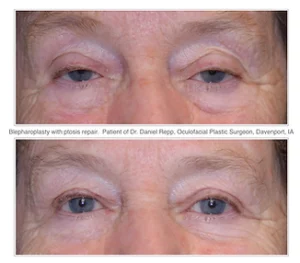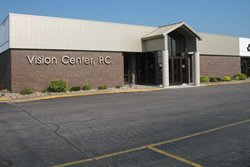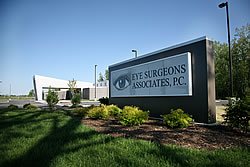What is ptosis?
Ptosis is condition when the upper eyelid droops, and when severe enough, can lead the upper eyelid to block the field of vision. True ptosis is caused by the lid itself falling downward – different than simply having extra baggy skin of the upper eyelid that blocks vision. When extra skin alone blocks vision, the condition is called dermatochalasis. Dermatochalasis, like ptosis, can be corrected with surgery. To see before and after pictures of eyelid lifting, view our before & after gallery.
What are some common symptoms?
The most common symptom is feeling like there is a shade over the eyes blocking vision. This can make reading particularly difficult. Many people also find that ptosis interferes with driving and watching TV, as ptosis can worsen their peripheral vision.
What causes ptosis?
There are a number of causes of ptosis. The most common type of ptosis is caused by a stretching of the connection between the eyelid and the muscle that lifts the eyelid. Imagine a garage, where you have a garage door, an electric motor to open the garage door and a bar connecting the motor and the door. The garage door is similar to the eyelid and the electric opener is like the lifting muscle. In the eyelid, the bar connecting the door and the motor is a type of tissue that is similar to a tendon – if this tissue stretches out, ptosis occurs.
There are many other types of ptosis, but these are much less common. In children, the eyelid lifting muscle may not fully develop, leading to an eyelid that moves up and down poorly. In some people, diseases of the nerves lead to ptosis. Imagine having a perfectly built garage door and opener, but not having a button to press to tell the door to open. This type of ptosis (neurologic ptosis) is rare. There are also other, rare types of drooping lids.
How does surgery work?
Surgery can help tighten the connection between the lifting muscle of the eyelid and the lid itself. By tightening this connection, the edge of the lid rises, restoring peripheral vision. Dr. Repp can tighten this connection using several different approaches.
One common approach is to make an incision in the natural eyelid crease. The natural eyelid crease allows your eyelid to fold into the eye socket in the same way that a garage door rises into a garage. Once the small incision is made, it gives Dr. Repp access to the muscle that lifts the eyelid. Dr. Repp can then tighten the connection between the eyelid and the lifting muscle. Dr. Repp can help camouflage the incision by placing it in your natural eyelid crease.
Another common approach to raising an eyelid is to tighten the connection between the eyelid and lifting muscle from the inside of the eyelid. This is an excellent technique, but it is not as powerful as working from the outside of the eyelid. Dr. Repp will be able to discuss what technique will work best for you.
Will surgery change the appearance of my eye?
Typically, surgery will not dramatically change the shape o f your eyes, but the goal of surgery is to make them open wider.
What can I expect the day of surgery?
Ptosis surgery is typically an outpatient, or day surgery, allowing you to recover at home following surgery. If needed, surgery of both upper eyelids is commonly performed at the same time. It is important to know that insurance will typically only pay for raising your eyelid – they typically will not pay for removal of extra skin at the same time. Some patients will elect to have surgery on their lower eyelids at the same time to treat lower eyelid bags. Insurance typically does not cover the cost of lower eyelid surgery either, but many patients still elect to have it done at the same time, as they only need one recovery.
What about recovery and aftercare?
Each patient is unique, but patients generally find they recover smoothly following surgery. The surgeon will customize an after-care plan for you, but some general guidelines follow. Ask Dr. Repp if these apply to you before following any of the recommendations on this site. And if something does not seem right, do not hesitate to call Dr. Repp.
Most patients will use frequent cool compresses for the first two days after surgery. During this time, the surgeon will likely ask you to limit activity, commonly recommending that you avoid any heavy lifting or bending. These activities can stress your surgery site and set your healing back. Following surgery, most patients experience only mild-to-moderate discomfort that can often be effectively treated at home with medications recommended by Dr. Repp. If you experience more than mild pain or discomfort, you should call Dr. Repp immediately for recommendations. You will also need regular ointment on your incision line. The ointment acts as a salve, soothing the eyelids as you heal.
Many patients wonder when they can safely return to work or other normal activities. There is no single answer for every patient, so ask Dr. Repp for details. The same is true for when patients can return to wearing their contact lenses, although many patients can begin wearing their soft contact lenses by two weeks and their hard lenses by one month. Check with Dr. Repp to see if these guidelines apply to you. Lastly, Dr. Repp will place sutures during your surgery. Typically, these are removed between one-to-two weeks following surgery. Ask Dr. Repp for details.






